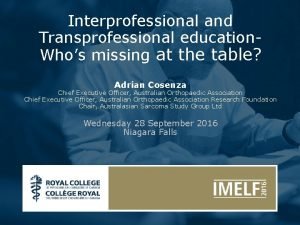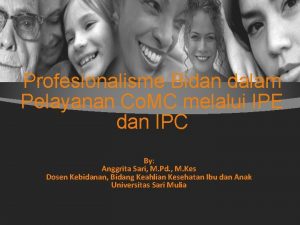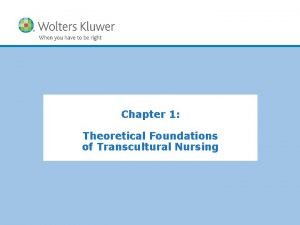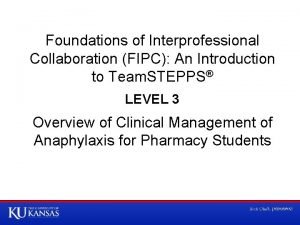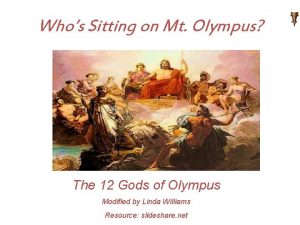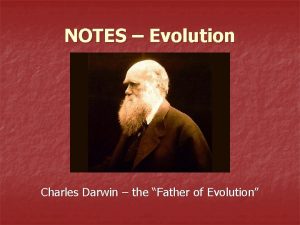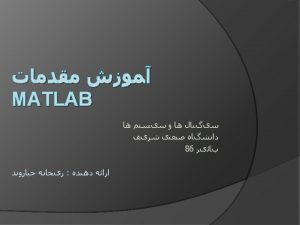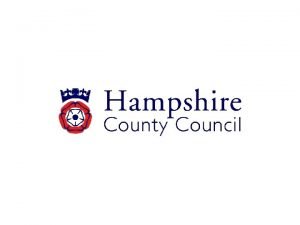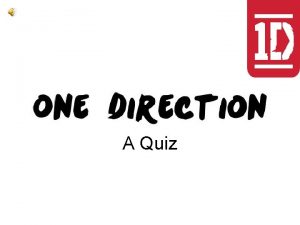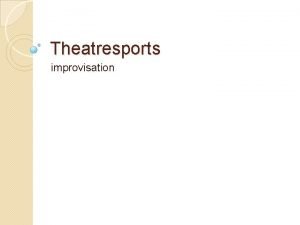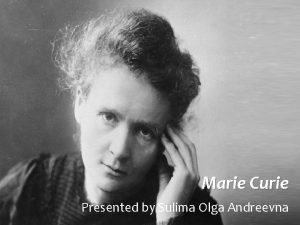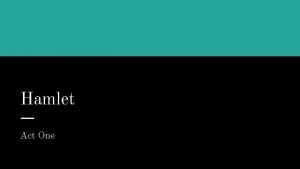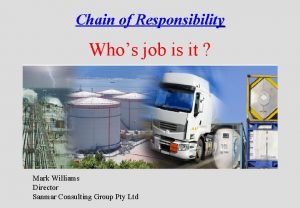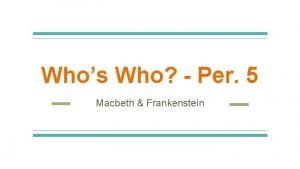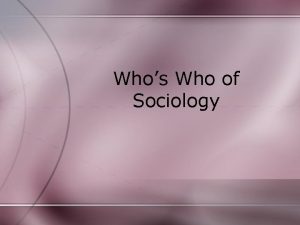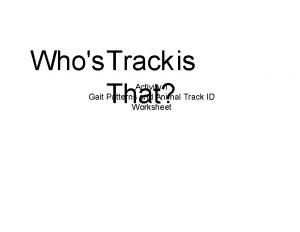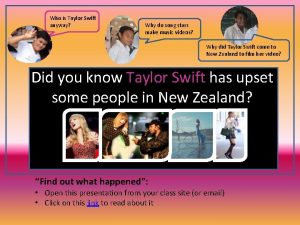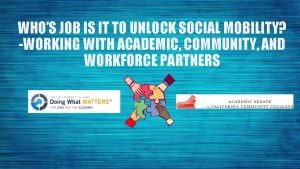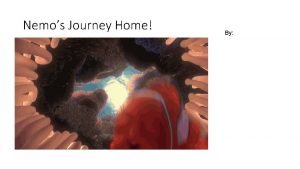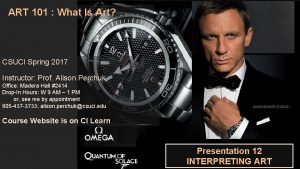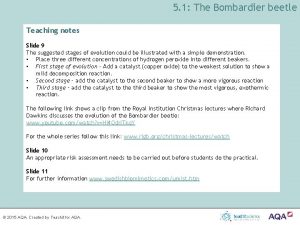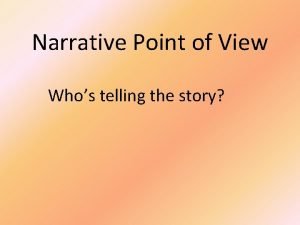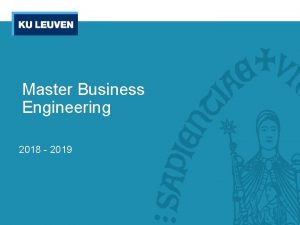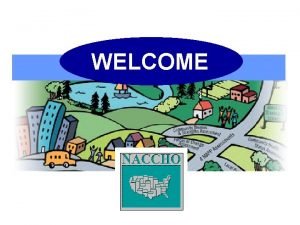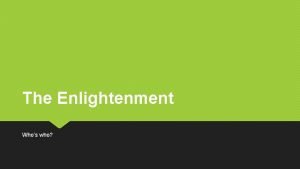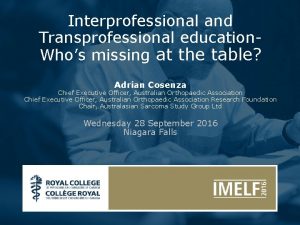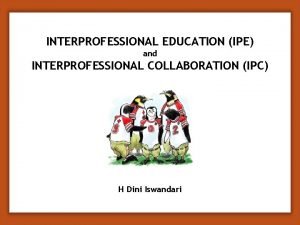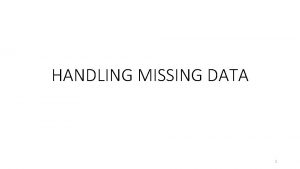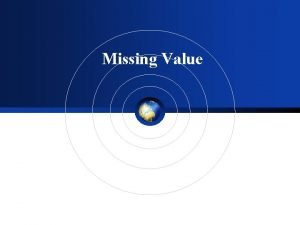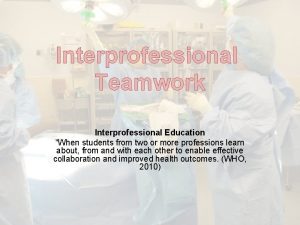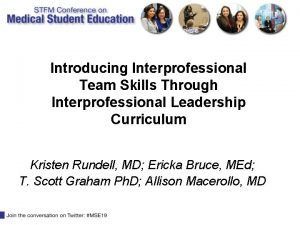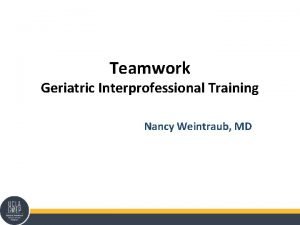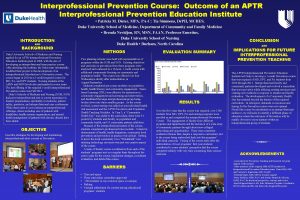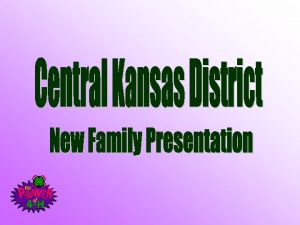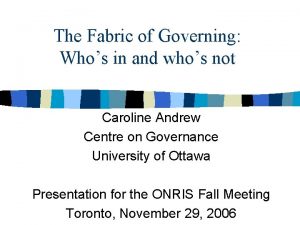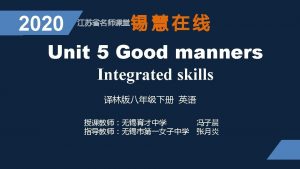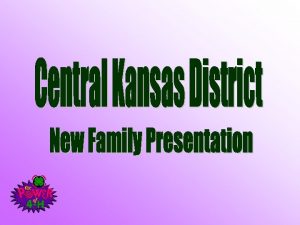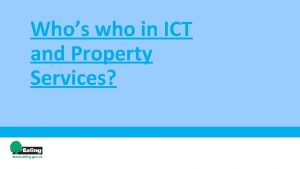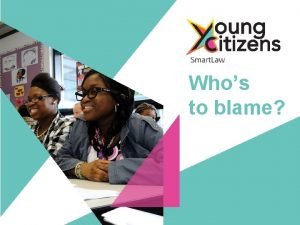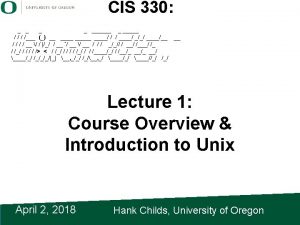Interprofessional and Transprofessional education Whos missing at the














































































- Slides: 78

Interprofessional and Transprofessional education. Who’s missing at the table? Adrian Cosenza Chief Executive Officer, Australian Orthopaedic Association Research Foundation Chair, Australasian Sarcoma Study Group Ltd Wednesday 28 September 2016 Niagara Falls

IMELF 2016 Agenda • • • Context – The Lancet Commission Environment Challenges & Opportunities Lessons from other sectors Way forward Brief table discussion & feedback

• • • Context – The Lancet Commission Environment Challenges & Opportunities Lessons from other sectors Way forward Brief table discussion & feedback


Health is all about people… • Health professionals are the service providers who link people to technology, information and knowledge • They are caregivers, communicators and educators, team members, managers, leaders and policy makers • As knowledge brokers health workers are the human faces of the health system • Professionals invariably are the leaders, planners and policy makers of health systems 5

Inter Professionals • Multidisciplinary inter professionals include social workers, nurses, therapists, doctors, counselors, surgeons – health professionals in the sector • For inter professional education, health needs teamwork • Multidisciplinary inter professionals are also required to collaborate with non health professionals - engineers, police, municipal officers and other professionals • “Inter professional education involves students of two or more professions learning together, especially about each other’s roles, by interacting with each other on a common education agenda” 6

Trans Professionals • Trans professionals are non- health sector professionals: health policy, communications, public relations, change managers, project managers, risk managers, strategy development, technology managers, advocacy, leaders • According to the Commissioners Trans professional teamwork might be of greater importance for health system performance, especially teamwork of professionals with basic and ancillary health workers, administrators and managers, policy makers and leaders of local communities. 7

Profession – what does it mean? • “A special kind of occupation” • “an avowal or promise” • Professionalism “signifies a set of values, behaviours and relationships that underpin the trust of the public” • “Professionalism was born of contradictory impulses. On the one hand, it belongs to the movement toward a democratic society and a free market economy. Professionalism promises to open careers to talent…on the other hand professions are monopolistic. . . ” • The need for a strong service ethic 8

Profession – relevant to other sectors • “What I would like to see is , really, banking return to be seen as a strong service profession. I do not know how far away from that we are. Banking, historically, has been a profession – a profession of stewardship, custodians, service, advisory, counsellor. It is not a marketing or product distribution business, banking is a profession. ” Dr. Phillip Lowe Reserve Bank of Australia, Governor 9

• • • Context – The Lancet Commissions Environment Challenges & Opportunities Lessons from other sectors Way forward Brief table discussion & feedback

Global Forces Demographic epidemiologic transitions Educated patients Co‐production Global change Private markets Social justice Biosciences ICT

A Recap – Problem Statement – the challenges • Inequities in health within and between countries • Health security challenged by new infectious, environmental and behavioural risks • Rapid demographic and epidemiological transitions • Health systems struggling…becoming more complex, placing additional demands on health workers 12

Professional Education is lagging… • Fragmented, outdated and static curricula that produce ill equipped graduates • Systemic problems include: • Mismatch of competencies to patient & population needs • Poor teamwork • Persistent gender stratification of professional status • Narrow technical focus without broader contextual understanding 13

Professional Education is lagging…systemic problems • Episodic encounters rather than continuous care • Quantitative and Qualitative imbalances in the professional labour market • Commercialism in the professions • Dysfunctional impact of the ‘tribalism of the professions’ • Professionals are falling short on appropriate competencies for effective teamwork & they are not exercising effective leadership to transform health systems 14

There is a fundamental linkage between professional education and health conditions • Interdependence of health is growing • Opportunities for mutual learning and shared progress have greatly expanded • Global movement of people, pathogens, technologies, financing, information, and knowledge underlie the international transfer of health risks and opportunities and flows across national borders are accelerating • Interdependence of health and education sectors is paramount 15

• • • Context – The Lancet Environment Challenges & Opportunities Lessons from other sectors Way forward Brief table discussion & feedback

Five years on…Are we still equipped and underprepared? • All reports concur that health professionals in the USA, the UK and Canada are not being adequately prepared in undergraduate, post graduate and continuing education to address challenges introduced by: • ageing, • changing patient populations, • cultural diversity, • chronic diseases, • care seeking behaviour and • heightened public expectations 17

“… insufficient information and a weak culture of monitoring…” • Professional education as a field has insufficient information and a weak culture of monitoring and evaluation • “Instructional design –It is noteworthy that we recorded little evidence in documenting the impact of effectiveness of educational innovations” 18

“…a third generation of reforms…” • …that emphasize patient and population centeredness, • competency based curriculum, • Inter professional and team based education, • IT-empowered learning • policy • management and • leadership skills • An emerging development globally refers to new forms of organisation, such as networks and partnerships, which take advantage of information and communication technologies 19

AOA 21 Curriculum Development

Technology: App

Technology: App

Future Ambition: Reforms for a second century • All Health professionals in all countries should be educated to mobilize knowledge and to engage in critical reasoning and ethical conduct so they are competent to participate in patient and population-centered health systems as members of locally responsive and globally connected teams. • Realizing the vision to be guided by two proposed outcomes; transformative learning & interdependence in education 23

Future Ambition: Shared Vision Common Strategy • Covering medicine, nursing, and public health • Beyond confines of national borders and silos of individual professions • A Global outlook; multi-professional perspective and a systems approach • Connectivity between education and health systems • The challenge – the professional education system must design new instructional and institutional strategies 24

Education System Structure Process Institutional Design • Stewardship • Accreditation • Collaboration • Financing Instructional Design Context Global-Local • • Criteria admission Competencies Channels Career Outcomes Interdependence in Education Transformative Learning

Competencies to be developed include… • Interdisciplinary teams, • Continuous quality improvement, • Use of new informatics, and integration of public health • Research skills, • Policy, • Law, • Management and • Leadership • …transprofessional education can assist 26

No different than a century ago, educational reform is a long and difficult process that demands leadership and requires changing perspectives, work styles, and good relationships between all stakeholders 27

• • • Context – The Lancet Commission Environment Challenges & Opportunities Lessons from other sectors Way forward Brief table discussion & feedback

IMD: Accessing World’s Best in Leadership Education • IMD is a top ranked business school • IMD is an expert in developing global leaders through high impact executive education • IMD aims to be best in the world in developing successful leaders, individual, teams and organisations. 29

Best in Class Credentials • First in Executive Education Worldwide Financial Times, Ranking 2012 ‐ 2016 • First in Open Program Worldwide – Financial 2012, 2013, 2014, 2015, 2016 Presentation to Board by Adrian Cosenza 5 th July

A Truly International Forum We have 379 participants from 51 countries, more than 200 companies and 6 Continents. Europe Austria Poland Belgium Portugal Bulgaria Romania Denmark Russia Finland Serbia France Republic of Slovak Germany Spain Hungary Sweden Ireland Switzerland Italy The Netherlands Lithuania Ukraine United Kingdom Norway North America United States Africa Nigeria Republic of South Africa South America Argentina Bolivia Brazil Chile Colombia El Salvador Mexico Asia & Middle East Oceania Australia Egypt Hong Kong India Indonesia Japan Kingdom of Saudi Arabia Malaysia People's Republic of China Republic of Korea Republic of Singapore Sultanate of Oman Taiwan, ROC Thailand United Arab Emirates Viet Nam Yemen 31

What are your challenges of delivering today and preparing for tomorrow? Presentation by Adrian Cosenza 28 th September 2016

Interview Overview: 156 CEOs/Senior Leaders Current Position Chairman, CEO, President 136 Other 20 Ownership Public HQ Location Number Industry Brazil/Latin America 19 FMCG US 15 Banking/PE/Ins Europe 59 Light Industry China 10 Shipping/Logistics India 11 Conglomerates Other Asia 30 NGO South Africa 12 Retailing Family/Public Private Equity NGO State/Other Presentation by Adrian Cosenza 28 th September 2016 Media Gender Number Advertising Male 139 Other Female 17

“I think there is an increasing reality everywhere in the world that the only constant [now] is change. The pace of change is getting faster and is unpredictable. The days of long‐term planning and predicting the future simply on the basis of the past are gone. The most important challenge for organisations is to create a point of view about the future and, at the same time, manage the short term more dynamically than ever before. ” Harish Manwani, COO, Unilever Presentation by Adrian Cosenza 28 th September 2016

Two extreme worlds today Intense, growing pressure for delivering results today!! Presentation by Adrian Cosenza 28 th September 2016 Acclerating pressure for long‐‐ term fundamental change!!

How leaders address long‐‐‐term issues? “Business people find it quite hard to intellectualize or contextualize issues over a five to ten year period. They’re pretty good over three years, but moving beyond that is tough. But the issue today is that a lot of the changes that businesses need to make to be successful in a volatile environment take longer than three years to prepare. ” Presentation by Adrian Cosenza 28 th September 2016 “Businessmen don’t spend enough time on ideas, the shaping of a problem. They go for the solution pretty quickly, and then make it fit a set of ideas. ”

New Assumption 1: Boundaries are fluid and permeable. Old World: Boundaries are closed and stable. Company serves customers. Satisfied customers pay more. Work separate from home. Strive for work-life balance. Presentation by Adrian Cosenza 28 th September 2016 New World: Boundaries are fluid and permeable. Company integrates customers. Satisfied customers promote the partnership. Work and home both flexible. Strive for work-life integration.

New Assumption 2: Power is broadly distributed, authority requires permission. Old World: Power and authority come from position. Position comes from (take your pick): wealth, inheritance, appointment, achievement, election… Presentation by Adrian Cosenza 28 th September 2016 New World: Power is broadly distributed, authority requires permission. Even once in authority, permission must be continuously negotiated. 10

New assumption 3: Success = Sustainability. Old World: Different parts of society / economy focus on different variables for overall success. Governments and third sector organizations look after everything that’s important but can’t be profitable. Presentation by Adrian Cosenza 28 th September 2016 New World: There is no success without economic, ecological and social sustainability for all players. Every business must contribute to social and ecological sustainability. Every organization must be economically viable, fund its own growth and reward its employees.

The new environment offers opportunities too great to ignore… for those who embrace the new assumptions. We can build… The environment is characterized by… Variety Collaborative opportunities Interdependence Technology If we operate with assumptions that… Boundaries are fluid Power is distributed Success = sustainability Presentation by Adrian Cosenza 28 th September 2016 Better Patient outcomes Sustainable success

3 Rs of Preparing Your Organisation • RETHINK your playing field • REDEFINE your ambition • RESHAPE how you work Presentation by Adrian Cosenza 28 th September 2016

Two observed responses in businesses Holding onto the Past! Presentation by Adrian Cosenza 28 th September 2016 Owning the Future!

From One Directional (Incremental) Planning to Two Directional Thinking “What rate of growth do we expect from our businesses” “Where do we “need/want” to be ‘x’ years from now” + 5% 5% Today + 5% Today Time Presentation by Adrian Cosenza 28 th September 2016 Time 10

Beyond Incremental Change In strategy, every end point is just the starting point for the next round of competition “If you don’t know where you’re going, any road will take you there” Cheshire Cat to Alice in “Alice's Adventures in Wonderland” by Lewis Carroll Presentation by Adrian Cosenza 28 th September

Not predicting the future but having a point of view, and beginning to prepare today • Building on awareness of trends reshaping the playing field • Building an aligned, shared point of view of the future— right or wrong • Incorporate in scenarios variables you can impact, not just those you can’t impact Presentation by Adrian Cosenza 28 th September 2016 We have had a lot of people looking at what it will take for leadership to be successful in the future. The first thing that came out as the biggest quality for the leadership is to be able to manage in ambiguity. If you are not able to manage in ambiguity, and you need to understand everything before you start doing something, you narrow everything and this will not work in the future. GE Executive

Identifying Sprints and Marathons: Transforming our Business Agenda for Action Takes time to develop new capabilities mindsets Sprints: Solidifying our Foundation Today’s Reality Future Ambition What Must we do to Prepare our Business for the Future What can we accelerate to fix/ strengthen our business today? Presentation by Adrian Cosenza 28 th September 2016 16

Transformative Learning for Leadership Level Objectives Outcome Informative • Information • Skills Experts Formative • Socialization • Values Professionals Transformative • Leadership attributes Change agents 16

• • • Context – The Lancet Commission Environment Challenges & Opportunities Lessons from other sectors Way forward Brief table discussion & feedback

The reforms required…. • Promote inter professional and trans professional education that breaks down professional silos while enhancing collaborative and non-hierarchical relationships in effective teams • Although team based learning has been practiced successfully for more than 20 years in non-medical settings, it has only been proposed recently as an instructional tool in health professional education 49

Individuals want…. • • • Belonging to a team means…. Autonomy Control Recognition • Giving up autonomy • Sharing Control • Sharing recognition Team Boundary Presentation by Adrian Cosenza 28 th September


University of Alberta Medical School

Inter – professional education The Australian Experience RACP IPE expressed as team work and collaboration in the PGME context. Learning occurs in the workplace. Values: Supervisor workshops focusing on values of working together – breaking down negative effects of tribalism. Standards: Curriculum emphasises team work Tasks: EPAs will set out tasks such as conducting interdisciplinary meetings 5

Inter – professional education The Australian Experience RADIATION ONCOLOGY “ Cross-discipline learning - working on building this but already happens in non-standardized way. We have multi-professional teams that already integrate well and do some educational activities together in-house e. g. QA and in scientific/educational fora. Leadership would work well across teams. Radiation therapist educators do a lot of medical trainee teaching in technical skills. This concept is a no-brainer for our specialty as it is part of the culture already” RACS Recognition of the health care team is woven into the RACS competencies and particularly described in the JDocs framework. It is assumed to be covered in hospital workplaces and thus acknowledged within SET surgical training. There may be aspects of the hidden curriculum that confound this. 5

TRANSPOFESSIONAL EDUCATION – AUSTRALIA EXPEREINCE The RACP works very effectively with many partners from private, commercial sector and organisations with specialist skills: KPMG Exam facilities Coaching providers Video and media and comms experts etc RADIATION ONCOLOGY - we have many educational and scientific/advocacy activities sponsored by equipment companies. Private practice sites have accredited training in some centres. No non-health educational organisations involved in training eg universities. No big threat at present. RACS 5

Adaptability: The New Competitive Advantage • Instead of being really good at doing some particular things, organisations must be really good at learning how to do new things • Those that thrive are quick to read and act on signals of change • Perhaps most important – they have learned to unlock their greatest resources: the people who work for them! 56

The Medical Board of Australia reports. . . on revalidation. . . Risk Management • Improving understanding of the risk profile of doctors • Developing a more accurate picture of risk indicators in Australia • Improving ways to predict risk • Improving understanding of timing and avenues for intervention 57

Adaptive Leadership • Hierarchical, command-control approaches simply do not work anymore • They impede information flows inside companies, tampering the fluid and collaborative nature of work today 58

Adaptive Leadership Navigating the Changing Environment • Manage the context in which actors interact, not the instruction set • Cultivate a diversity of perspectives to generate a multiplicity of options • Allow leadership to be shared and to emerge • Constantly question the world around you 59

Leading Transformation Building the Right Team, Organisation and Culture • Transformation requires focus, commitment and engagement • Best laid plans fail unless people are on board • There is not a magic formula 60

3 Rs of Preparing Your Organisation • RETHINK your playing field • REDEFINE your ambition • RESHAPE how you work Presentation by Adrian Cosenza 28 th September 2016

From Reactive to Proactive Agendas REACTIVE ACTIVITIES: Addressing symptoms of issues through activity PROACTIVE AGENDA: Two‐directional thinking • Too many initiatives • Focus on reactive firefighting on immediate problems • Focus on tasks, not how they create an agenda • Identifying and addressing root causes of challenges and opportunities • Break limitations and barriers from traditional assumptions • Focuses on what we must do to succeed, not what we can do today or have done in the past Presentation by Adrian Cosenza 28 th September 2016

Reshaping How You Work 1. Defining Sprints and Marathons 2. Embracing Interdependence in interactions with stakeholders 3. Expect the courage, capacity and commitment for continual challenge Presentation by Adrian Cosenza 28 th September 2016

Penny Ballen a keynote speaker at TISLEP 2015 & a physician implored the medical profession to seek further education in leadership… • Broadening their skills is of benefit to patients, their practice, hospitals, health jurisdictions and the community • Skills required of physician leaders of the future include: • Risk management, communication, change management, project management, media handling, brand marketing concepts, health formulation, technology, advocacy and community engagement. 64

Dr. David Asch a keynote speaker at the opening session at ICRE 2015 delivered a provocative session… • . . . Imploring medical education to move from ‘process driven’ to ‘customer driven’ • This cultural transformation has been experienced in other sectors and industries across the globe • Dr. Asch said the medical profession could learn from other professions and business • There needs to be a hunger for leadership development and lessons for physicians 65

Trans professional education in Orthoapedics • American Orthoapedic Association is oldest orthopaedic association in the world • Leadership is its mantra • Has worked with Business Schools to develop leadership programs for orthopaedic surgeons • AOA works with ethicists, Public relations consultants, governance experts, auditors, risk managers, health economists, lobbyists, policy makers, strategists, program and project managers, communication experts, technology partners, leadership experts etc. …lifelong learning 66

What would it be like if you…. • …have the rigor and discipline for delivering today, but also the passion and vision for shaping the future • …have strong connections with key stakeholders built on a commitment to mutual success • …have informed, diverse employees working together with empowerment to delivery today and engagement to co‐create the future • Isn’t your job as a leader to make this a reality? Presentation by Adrian Cosenza 28 th September

We generally encountered two types of leaders • Overwhelmed • Informed • Oblivious • Insightful • Opportunistic • Inspirational Where are you? Presentation by Adrian Cosenza 28 th September Where is IMELF?

The Commissioners’ Call to Action… • Global Social Movement of all stakeholders, educators, students, young health workers, professional bodies, universities, non-government organisations, international agencies, donors and foundations- that can propel action on the vision • Global health – consensus about is key tenets – universalism, global perspectives in discovery and translation, inclusion of broad determinants of health, interdisciplinary approaches and comprehensive framework 69

The Commissioners’ Call Action… to • Professions have special obligations and responsibilities to acquire competencies and undertake functions beyond purely technical tasks – such as teamwork, ethical conduct, critical analysis, coping with uncertainty, scientific enquiry, anticipating and planning for the future and leadership of effective health systems • The vision is global rather than parochial, multiprofessional and not confined to one group, committed to building sound evidence, encompassing of both individual and population based approaches and focussed on instructional and institutional innovations 70

A Model Case Study in Multi professional, inter professional, trans professional and cross border collaboration and alliance • APEC Business ethics forum for small & medium enterprises (SME) in Health – commenced in 2010 • “From a patient perspective APEC serves a vital role in elevating high standard ethical practices for health systems which facilitates access to lifesaving medical technologies across borders”…International Alliance of Patient Organizations • Health System stakeholders in Peru and Canada have launched landmark collaborative arrangements to strengthen ethical interactions • Peru and Canada’s ‘consensus frameworks’ bring together health agencies, associations, practitioners, hospital groups and patient organizations to jointly develop and adopt codes of ethics 71

A Model Case Study in Multi professional, inter professional, trans professional and cross border collaboration and alliance…cont. . . • It positions them to more effectively address improper inducements and ensure patient interests while providing a foundation for relevant parties elsewhere in the Pacific Rim to build on this progress • The frameworks support ethics training across health systems, including for employees of SME. • The approach could significantly increase health care outcomes • “It is essential for the health industry to work in unison to build public trust. . . ” Dr Particia Garcia, Minister of Health, Peru • Aligned Codes advance ethical collaboration, foster innovation and instill integrity in medical deciison making 72

IMELF delegates are already thinking about…who is missing. . . Americas • “This is a controversial topic and PGME leaders are nervous about involving “big bad industry” and fear losing control • Maybe it’s time to re-think – provided the PGME and industry understand each other’s expertise, we don’t need to compromise ethics or standards • This collaboration could be an agent for change • Analogy was made with a senior medical leader requiring knowledge in Finance, HR, etc. ” 73

So, who is missing at the table? 74

• • • Context – The Lancet Commission Environment Challenges & Opportunities Lessons from other sectors Way forward Brief table discussion & feedback

Question #4 – Recommendation (Plenary/Session #3) With a view to transform the quality of healthcare delivery through our residency education practices, which healthcare stakeholders should be included in this forum? Summarize your top 2 short term (within the next year) and long term (within 5 years) recommendations. Tables 1 -9 76

Question #5 – Recommendation (Plenary/Session #3) Recognizing the importance of building networks to improve healthcare through residency education, what global healthcare organizations should be invited? Are there any healthcare industries or non-healthcare corporations that should be included and why? Summarize your top 2 short term (within the next year) and long term (within 5 years) recommendations. Tables 10 -18 77

Interprofessional and Transprofessional education. Who’s missing at the table? Adrian Cosenza Chief Executive Officer Australian Orthopaedic Association Chair, Australasian Sarcoma Study Group Ltd Tuesday 28 September 2016
 Educational reform
Educational reform Ipe dalam kebidanan
Ipe dalam kebidanan Sunrise enabler
Sunrise enabler Interprofessional care for anaphylaxis
Interprofessional care for anaphylaxis Who is the thane of glamis in macbeth
Who is the thane of glamis in macbeth Whos a famous painter
Whos a famous painter Whos roman name is diana
Whos roman name is diana Whos achilles
Whos achilles Adjectives to describe prince escalus
Adjectives to describe prince escalus Whos the father of evolution
Whos the father of evolution Clear workspace matlab
Clear workspace matlab Whos entitled to 30 hours free childcare
Whos entitled to 30 hours free childcare Whos darwin
Whos darwin Whos boxer in animal farm
Whos boxer in animal farm Whos the youngest one direction member
Whos the youngest one direction member Whos line is it anyway
Whos line is it anyway Whos sitting bull
Whos sitting bull Whos marie curie
Whos marie curie Marie curie was born maria sklodowski
Marie curie was born maria sklodowski Hamlet character constellation
Hamlet character constellation Whos job is it
Whos job is it Whos adam smith
Whos adam smith Whose child is this
Whose child is this Whos the thane of fife
Whos the thane of fife Whos jane addams
Whos jane addams Activity 1 who's who
Activity 1 who's who Who is taylor swift anyway
Who is taylor swift anyway Whos for the game jessie pope
Whos for the game jessie pope Conflict in the lottery by shirley jackson
Conflict in the lottery by shirley jackson Comrades you all hear about the strange dream
Comrades you all hear about the strange dream Whos job is it
Whos job is it Whos the author
Whos the author Nemo first day of school gif
Nemo first day of school gif Whos this
Whos this Who is this
Who is this Pleisomorphy
Pleisomorphy Whos telling the story
Whos telling the story Ku leuven whos who
Ku leuven whos who Jeopardy macbeth
Jeopardy macbeth Button button whos got the button
Button button whos got the button Whos here
Whos here Im watching tv
Im watching tv Whos who ideas
Whos who ideas Macbeth questions and answers
Macbeth questions and answers Macbeth questions and answers
Macbeth questions and answers Whos macduff in macbeth
Whos macduff in macbeth Hát kết hợp bộ gõ cơ thể
Hát kết hợp bộ gõ cơ thể Ng-html
Ng-html Bổ thể
Bổ thể Tỉ lệ cơ thể trẻ em
Tỉ lệ cơ thể trẻ em Voi kéo gỗ như thế nào
Voi kéo gỗ như thế nào Chụp tư thế worms-breton
Chụp tư thế worms-breton Bài hát chúa yêu trần thế alleluia
Bài hát chúa yêu trần thế alleluia Các môn thể thao bắt đầu bằng tiếng nhảy
Các môn thể thao bắt đầu bằng tiếng nhảy Thế nào là hệ số cao nhất
Thế nào là hệ số cao nhất Các châu lục và đại dương trên thế giới
Các châu lục và đại dương trên thế giới Công thức tính thế năng
Công thức tính thế năng Trời xanh đây là của chúng ta thể thơ
Trời xanh đây là của chúng ta thể thơ Mật thư anh em như thể tay chân
Mật thư anh em như thể tay chân Phép trừ bù
Phép trừ bù Phản ứng thế ankan
Phản ứng thế ankan Các châu lục và đại dương trên thế giới
Các châu lục và đại dương trên thế giới Thơ thất ngôn tứ tuyệt đường luật
Thơ thất ngôn tứ tuyệt đường luật Quá trình desamine hóa có thể tạo ra
Quá trình desamine hóa có thể tạo ra Một số thể thơ truyền thống
Một số thể thơ truyền thống Cái miệng nó xinh thế
Cái miệng nó xinh thế Vẽ hình chiếu vuông góc của vật thể sau
Vẽ hình chiếu vuông góc của vật thể sau Biện pháp chống mỏi cơ
Biện pháp chống mỏi cơ đặc điểm cơ thể của người tối cổ
đặc điểm cơ thể của người tối cổ Giọng cùng tên là
Giọng cùng tên là Vẽ hình chiếu đứng bằng cạnh của vật thể
Vẽ hình chiếu đứng bằng cạnh của vật thể Fecboak
Fecboak Thẻ vin
Thẻ vin đại từ thay thế
đại từ thay thế điện thế nghỉ
điện thế nghỉ Tư thế ngồi viết
Tư thế ngồi viết Diễn thế sinh thái là
Diễn thế sinh thái là Dot
Dot So nguyen to
So nguyen to
